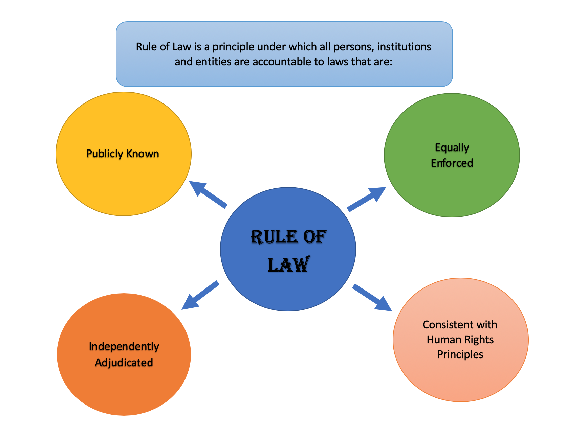7.1: Rule of Law
- Page ID
- 16135
The rule of law suggests that the creation of laws, their enforcement, and the relationships among legal rules are legally regulated, so that no one, including highly placed individuals are above the law. The legal constraint on those in charge means that government officials are subject to existing laws as much as its citizens are. Rule of Law is based on the belief of equality before the law, which holds that no person shall enjoy legal privileges that are not extended to all, and that no person shall be immune from legal consequences for criminal behavior.
In addition, the application and adjudication of legal rules by the police, prosecutors and the courts are to be impartial and consistent across equivalent cases. The evidence should be weighted blindly without taking into consideration the class, status, or relative power among those involved in civil or criminal matters. In order for those principles to have any real application, there should be in place legal apparatus for compelling government officials to submit to the law.

Such was the case brought before the United States Supreme Court in United States v. Nixon regarding executive privileges criminal matters. A grand jury returned indictments against seven of President Richard Nixon's closest aides in the Watergate burglary. The special prosecutor appointed by President Nixon sought audio tapes of conversations recorded by President Nixon in the Oval Office. President Nixon asserted that he was immune from the subpoena claiming, "executive privilege," which is the right to withhold information from other government branches to preserve confidential communications within the executive branch or to secure the national interest.
In a unanimous decision the United States Supreme Court held that neither the doctrine of separation of powers, nor the generalized need for confidentiality of high-level communications, without more, can sustain an absolute, unqualified, presidential privilege. The Court granted that there was a limited executive privilege in areas of military or diplomatic affairs but gave preference to "the fundamental demands of due process of law in the fair administration of justice." Therefore, the president must obey the subpoena and produce the tapes and documents. The rule of law was applied to the powerful just as would apply to those without power.
The Rule of Law entails such basic requirements about how the law should be enacted in society, it also suggests certain qualities about the content of the laws themselves. Laws must be open and clear, general in form, equal in application, and known to all. Legal requirements must be such that people are able to follow them. The law must not place undue intelligence or behavioral demands on people. The law should be relatively stable, so people can consult before acting, and legal obligations should not be retroactively established.
In spite of these basic consideration, and attempts by jurists and political philosophers, there is no generally accepted or even systematic formulation of the Rule of Law. The idea that the law should contribute to the betterment of society and constraining the exercise of public power can be interpreted in different ways; which leads to different philosophy and application of the Rule of Law.
The majority of modern democratic societies, and certainly in the United States the Rule of Law’s requirement that both those who govern and those governed are held accountable to the law is of unquestionable principle.
After the American Civil War, the federal government expanded the vote to blacks in the old confederate states, providing some equal protection. When Southern states were once again granted self-governance, those in power were predominately white. They began to enact laws that oppressed blacks through segregation and disenfranchisement.
The 1875 Civil Rights Act had stated that all races were entitled to equal treatment in public accommodations, however in 1883 with an 8-1 decision Civil Right Cases the United States Supreme Court ruled the Civil Rights only applied to the Federal and State governments, but had no application to private persons or business' open to the public.
In 1892, Homer Plessy boarded a train in New Orleans and sat in the car reserved for whites only. Plessy, who was only one-eighth black, but classified as black by Louisiana law, refused to leave and was arrested, which triggered a case challenging the legality of segregation. In 1896, the Supreme Court ruled that “separate but equal” was fair and was not a violation of the Fourteenth Amendment requiring equal protection to all.
After the Plessy v. Ferguson decision, segregation became even more entrenched in the former confederate states through a series of laws and social customs known as “Jim Crow” laws. State schools, theaters, restaurants, and transportation vehicles were segregated. Poll taxes and literacy requirements not only prevented blacks from voting, but also made them ineligible to serve on jury pools or run for public office. “Separate but equal” remained unchallenged until the Supreme Courts re-visited segregation in 1954 with the Brown v. Board of Education reversing Plessy. Eventually congress passed the Civil Rights Act of 1964, finally fully implementing the protections guaranteed under the 13th and 14th Amendments of the Constitution.
Supreme Court Justice Stephen Breyer has stated “Maintaining a rule of law is more difficult than many believe. The effort is ancient, stretching back to the Magna Carta, and still earlier.” Justice Breyer was attempting to emphasize the challenges of maintaining an equitable system that incorporates the rule of law. Many have tried for hundreds of years and it still in not perfected.

